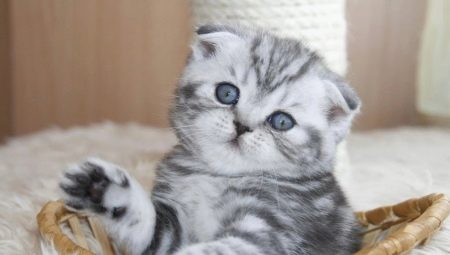Scottish fold kittens are considered one of the most charming pets. They have an easygoing character, good health and get along well with other pets. In order for the baby to turn into a beautiful big cat and become a true friend for many years, it is necessary to provide it with the right diet and proper care.
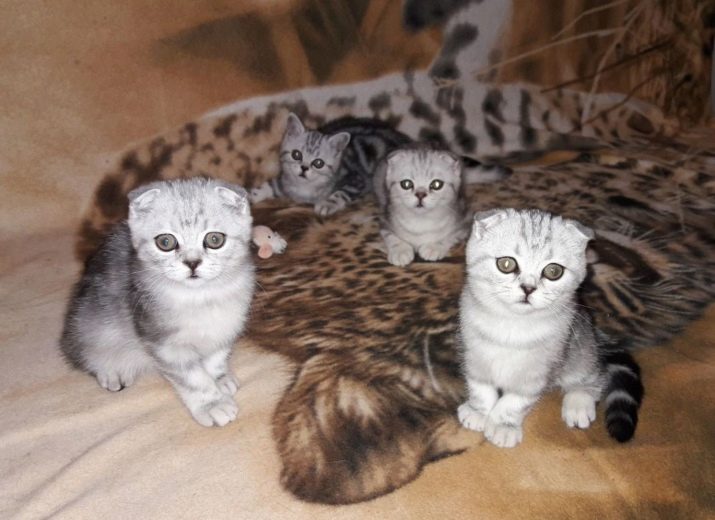
Breed features
Scots from birth have straight ears, which acquire the final shape by the age of three months of the kitten. This breed is often confused with the British, but its representatives are characterized by their own characteristics. Unlike the former, fold scots are characterized by an even character, gentleness and complaisance. British cats, on the contrary, are independent and arrogant. In addition, lop-eared beauties are very smart and easy to learn, they never scratch furniture, do not tear curtains and do not break vases.
Scottish fold have excellent health and, with proper care, can live up to 15 years. The paws and neck of cats are short and powerful, their muscles are well developed. Unlike other cat breeds, Scots have triangular small ears that are firmly pressed to the skull, their tips are directed slightly down due to the specific structure of the cartilage.
These pets have a luxurious fur coat, its color can be different, starting from snow-white, black, cream, blue and ending with marble, smoky and silver shades.
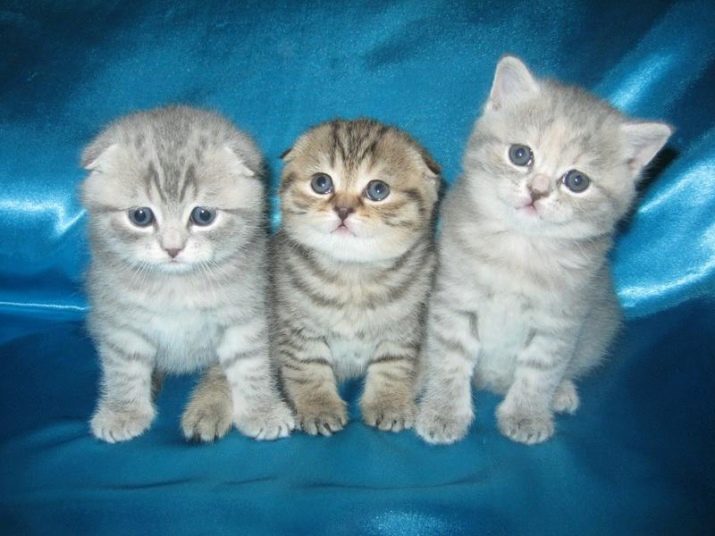
Before you get a Scottish fold baby in the house, you need to be prepared for the fact that he will require a lot of attention to his person.The baby should not only receive good nutrition and care, but also have constant communication with the owners. The main feature of this breed is the inability to meow; instead, representatives of the feline genus emit sounds that resemble a creak. In addition, these cats can only move and sit on their hind legs and like to sleep on the back.
These cats have a thickening in the sideburn area, because of which it seems that the animal is constantly smiling.
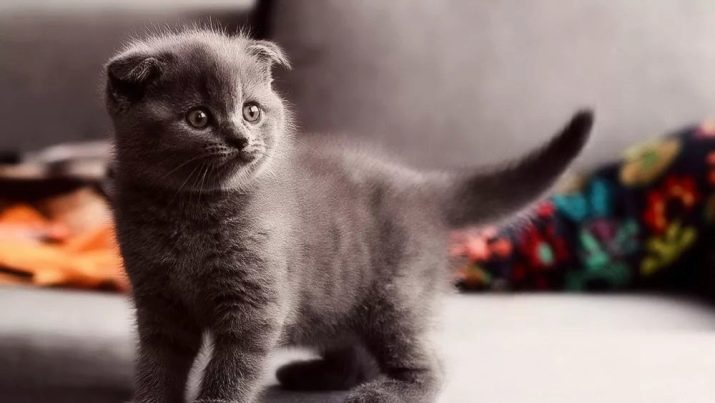
What to do before the appearance of Scottish fold?
Lop-eared Scots are usually ready for an independent life at 2-3 months of life, just at that time they are weaned from their mother, but before getting this kitten, you need to carefully prepare everything.
- First of all, you should buy dishes, from which the baby will eat and drink. It is best to give preference to stainless steel or porcelain bowls, and a container made of food-grade plastic may also be suitable. Additionally, you will need to buy toys, a house and a tray with a filler. Since the kitten will need to be shown to the veterinarian periodically, it is necessary to buy a spacious carrier, it will come in handy when traveling to the country.
- The next stage of preparation will be the preparation of the daily regimen and the selection of a balanced diet. At first, a little handsome is not recommended to give dry food.
- The final step will be to prepare a place for the house. It should be protected from drafts and not noisy so that the pet can rest comfortably (fold scots - big dormouse). When the animal gets used to the new habitat, it will gradually begin to examine the entire space of the room. During this period, the crumbs must be given maximum attention and bestowed with his caress.
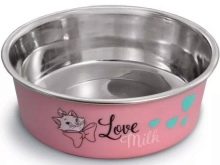
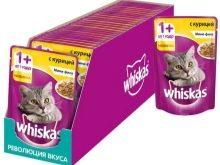
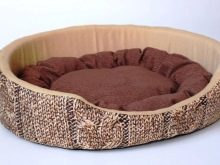
Care Rules
Scottish cats are undemanding in content, but to properly follow them To care, you must first study their basic habits and character.
- Absolutely all representatives of the Scottish fold breed are considered to be clean animals and like to have their own place, where they sometimes prefer to be alone.
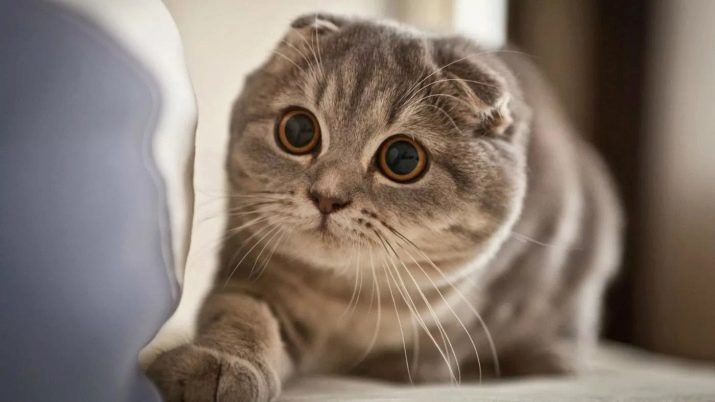
- These kittens are usually purchased at the age of 2 months, after which the pussies need to be provided with proper care, taking into account the following points:
- balanced and timely nutrition;
- the presence of a scratching post and a clean toilet;
- arrangement of a berth.
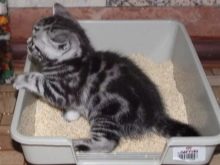

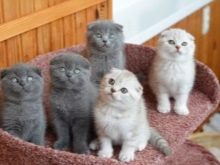
- The main thing in the care of the Scots is the organization of the toilet, which includes the constant replacement of the filler. Experts recommend using the type of filler that was used in the nursery where the kitten lived. Thanks to this baby you don’t have to adapt for a long time. A huge role is played by the choice of a toilet tray: if the Scot doesn’t like it, will be placed in an inconvenient place or not cleaned in time, then the kitten goes to the toilet in any other place. If this happened, you can’t punish the animal, this will not lead to good results, but, on the contrary, will cause aggression.
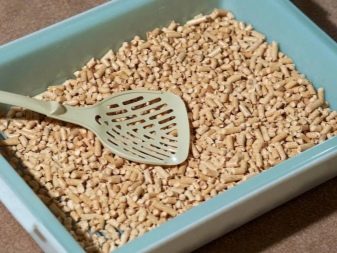
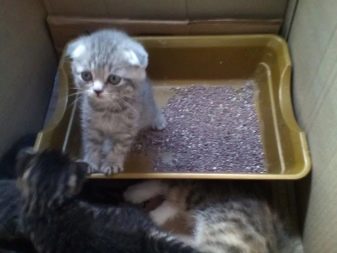
- Equally important is the arrangement of a berth. The pet should have a comfortable house where he can sleep and take refuge. If the sleeping place is organized correctly, then the kitten will not sleep in the wrong places and bother with its presence. The animal house must be periodically cleaned and washed. Mandatory additions to the Scottish housing are a scratching post and toys (mice, balls, etc.).
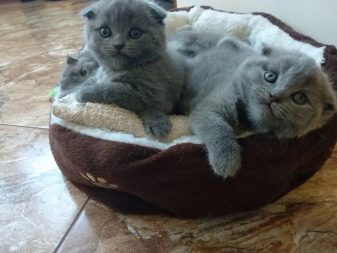
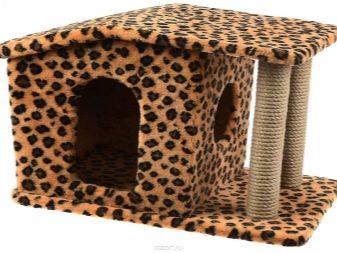
- An integral part of the care of fold Scottish people is to carry out hygiene procedures, including:
- hair and ear care;
- timely bathing;
- clipping and cleaning claws;
- eye examination.


- Since the representatives of this breed have a specific structure of the ears, they need to pay great attention to regular cleaning. The cleaning procedure is simple: each ear must be turned off in turn and gently wipe the auricle with a wet swab.If traces of light sulfur remain on the swab after cleaning, this means that the pet is healthy. If there is a specific and unpleasant odor, which is accompanied by a discharge of yellow sulfur, it is necessary to immediately show the baby to the veterinarian, as this may indicate the presence of an infectious disease.

- The eyes also require special care: in the Scots, the lacrimal canal is often infected. In the event that they are not inspected or cleaned, brown or purulent discharge may appear. To prevent this, the kitten should be cleaned daily with a wet swab.
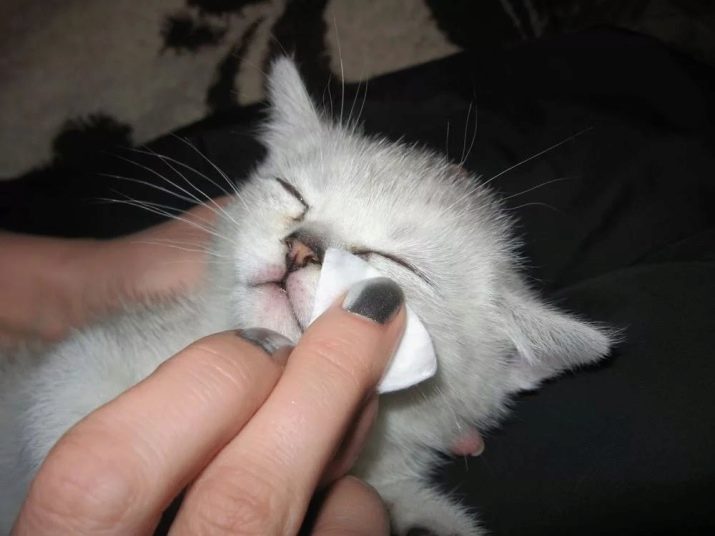
- Several times a month, the pet needs to trim its claws. This must be done carefully without damaging the blood vessels. It is best to teach a cat to this procedure from early childhood, this will facilitate further care. It is advisable to cut the claws with special scissors, which can be purchased at any pet store. The claw point will also help clean the claws.
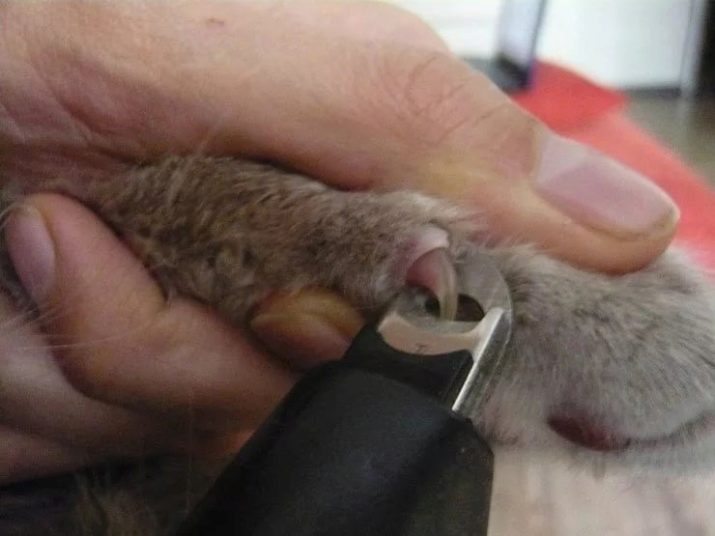
- The cartilages and bones of the Scots are very fragile, therefore, special attention should be paid to caring for the oral cavity of an animal, which consists of regular examination of teeth and their cleaning from plaque and stone. The teeth of the cat should be white, without blotches, and the gums should be pink. If wounds are noticed in the mouth, you should immediately consult a specialist who will prescribe treatment. In this case, the fold Scottish is forbidden to give solid food until complete recovery.
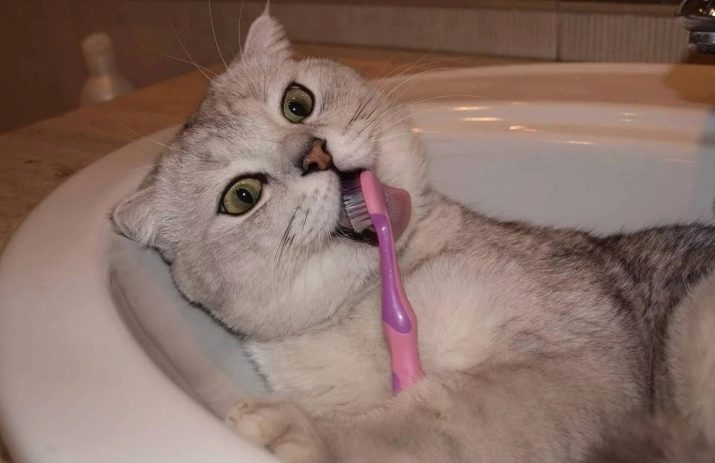
- Since cats of this breed are notable for their cleanliness, care must be taken to properly care for the coat when they are kept, providing combing and bathing with the use of special lotions. Since cats have thick hair, the intestinal tract often clogs when it is licked. To avoid this, water procedures and regular combing with wooden or plastic combs with wide teeth will help. If you ensure proper hygiene of the coat, then you can not worry about the appearance of fleas and ticks.
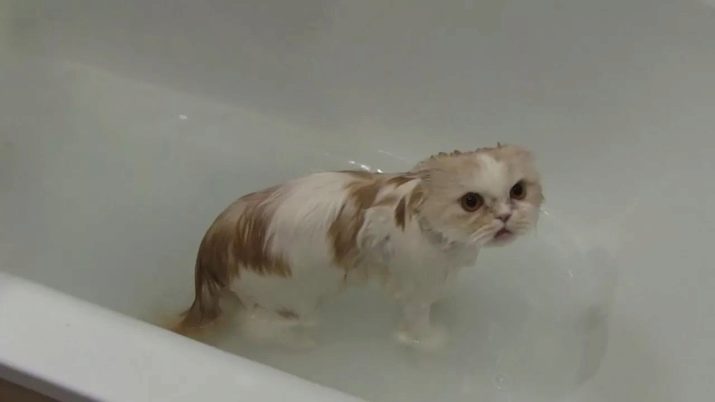
Food
The lop-eared Scottish kitten must eat right. Since representatives of this breed are prone to rapid weight gain, their portions should be limited from childhood and control the diet so that it is complete. Many owners, after acquiring pussies, prefer to give them the food that was used in the nursery, but this is wrong. When compiling a diet, the following recommendations should be considered:
- you can feed the fold Scots only with natural food intended exclusively for cats;
- it is allowed to add canned foods, wet mixtures and dry food to the daily diet of pets;
- You can periodically combine natural feed with artificial feed.
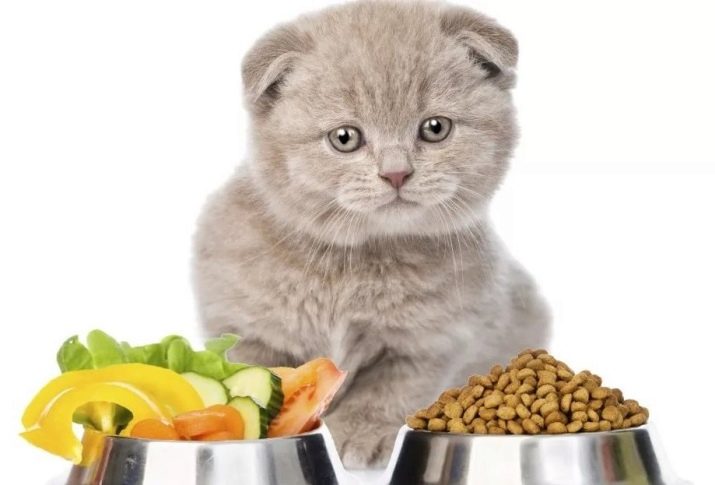
In this case, it is best to combine wet food with dry food, this will provide the cat with a balanced diet and will not be addictive.
When feeding a kitten with canned products, you need to remember that they should not contain dyes and preservatives. Supplements in the form of useful trace elements and vitamins will not interfere with the baby. Forbidden products include:
- legumes;
- raw fish;
- potatoes;
- all kinds of herbs and spices.
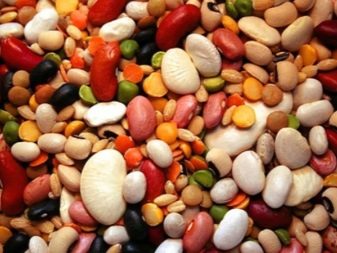

Recommended products include:
- boiled or raw vegetables;
- dietary meat of rabbit, chicken and turkey (it is pre-boiled and crushed);
- sour milk non-fat products;
- sea fish (it is cleaned of bones and boiled);
- all kinds of cereals mixed in equal proportions with fish or meat.

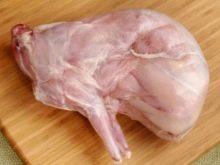
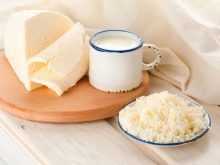
If the kitten is provided with a balanced and healthy diet, the digestive tract will work well, and over time, an active cat will grow out of crumbs, which can give joy to the owners for many years.
Trained to the tray
Usually little Scots get used to the toilet seat from an early age, while still in the nursery.After acquiring the animal and settling it in a new place, it takes a certain time for adaptation. Therefore, owners of fluff should pay special attention to the toilet, choosing the filler of the same brand as it was before. Scottish kittens love when the toilet is filled with silica gel, as it makes rustling sounds. In addition, this filler perfectly retains unpleasant odors.
Sometimes it happens that the acquired baby is not familiar with the rules of the cat's toilet. In this case, it must be immediately accustomed to the tray, otherwise the animal will remain in the habit of relieving itself anywhere. Placing the tray in a place that is easily accessible to the kitten will facilitate the process of getting used to, but it should be hidden from prying eyes.. It is best to allocate a toilet space in the pantry or bathroom, but the door there must be constantly open.
If the Scot categorically refuses to visit the tray, you need to replace the filler or place the toilet in another place.
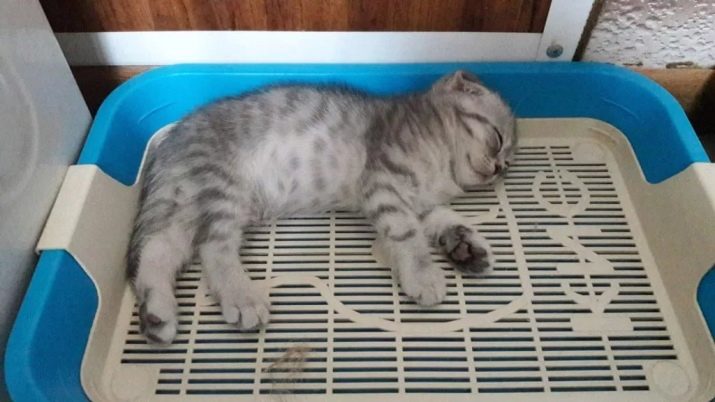
Vaccination
Despite the fact that the Fold Scots are famous for good health, they can still manifest various types of diseases, among which the "hard tail" is considered common. This disease is characterized by the formation of some seals on the tail caused by a gene mutation, and is noticed, as a rule, after several weeks from the birth of a kitten. Such seals not only create pain for the animal, but can also lead to paralysis or death. To prevent this, kittens should be purchased only in specialized nurseries where they are vaccinated. After a small miracle has appeared in the house, it is important to worry about getting it all the necessary set of vaccinations. It is worth noting that you can only vaccinate a healthy cat.
At the age of one month, for the prevention of worms, the baby is given a special suspension. It also needs to be given every four months.
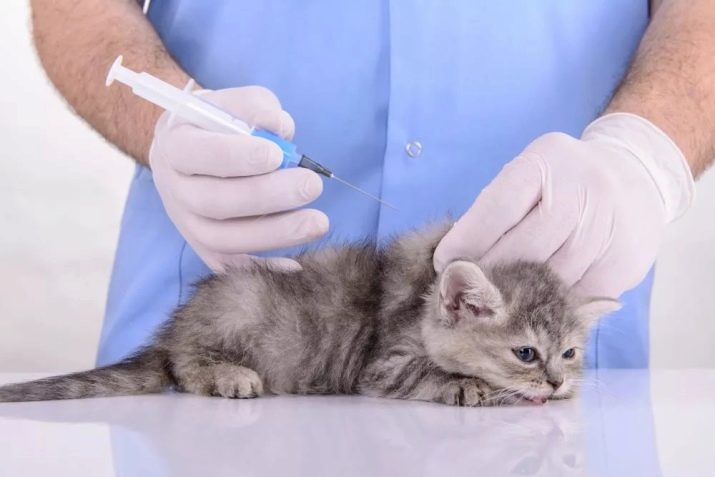
The first vaccination is usually performed at the age of three months of the Scotsman, for this a complex vaccine is used, the action of which is directed simultaneously against several diseases. The reaction is monitored three weeks after vaccination, and this vaccine is then given every year. When the kitten reaches the age of 3 to 6 months, they are vaccinated against ringworm, and vaccinated against rabies per year. Any owner can get more detailed information about the types and terms of vaccination at the veterinarian who will register the pet and will note the vaccinations in his passport.
The care of the fold Scot is described in the next video.
